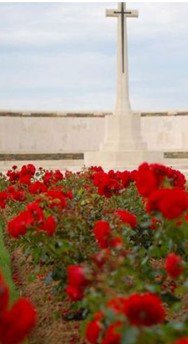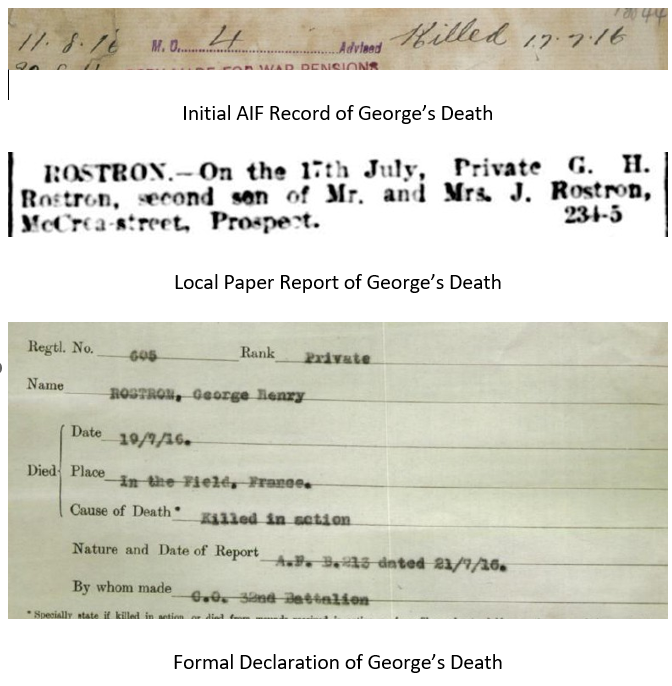Private George Henry ROSTRON
Eyes blue, Hair brown, Complexion fair
George Rostron – England, America and Australia
Can you help us identify George?
George was killed in Action at Fromelles. As part of the 32nd Battalion he was positioned near where the Germans collected soldiers who were later buried at Pheasant Wood. There is a chance he might be identified, but we need help.
In 2008 a mass grave was found at Fromelles, a grave the Germans dug for 250 (Australian) bodies they recovered after the battle. As of 2024, 180 of these soldiers have been identified via DNA testing. We are still searching for suitable family DNA donors for George.
If you know anything of contacts for George here in Australia or his relatives from England, please contact the Fromelles Association.
See the DNA box at the end of the story for what we do know about his family.
Early Life – England, America and Australia
George Henry Rostron was born on 28 June 1897 in Chelsea, England. His parents were James and Kate Louisa (nee Laws) Rostron and his siblings were:
- Alice - 1882
- James (Jim) -1892
- John Leonard (Jack) - 1900
- Albert Edward (Ted) - 1901
- Edith Sarah (“E”) – 1908
James was a painter and when Kate was in her teens she worked as domestic staff for a solicitor who lived at 99 Piccadilly, London, an upmarket address. While they and their families had ‘working class’ jobs, James and Kate managed to travel to New York on several occasions. Kate first went to the US in 1870 when she was just three, but she was back in England in the next year. James sailed to the US in 1886, accompanied by Alice who was just three.
This is some years before James and Kate married so presumably Alice was from an earlier relationship or possibly a child from James’ family. She was an integral part of George’s family. We do not know how James and Kate’s paths crossed, but they were married in Manhattan, New York in 1891 and lived on Amsterdam Avenue, near Broadway. Jim was born there in 1892. The family moved back to England, but Kate and Alice and Jim sailed from Liverpool to New York in December 1895.
By the time George was born in 1897, all had returned to England. In 1901 they were living at 5 Adpar Street Paddington, London.
Their last big move was in 1908 when they emigrated to South Australia aboard the Narrung, arriving on 30 September. They lived on Alpha Road, Prospect, South Australia, just north of the Adelaide CBD.
With their father being a painter, all the Rostron sons became tradesmen - George was a carpenter, Ted and Jim followed their father into the painting trade and Jack was a bedstead maker.
Off to War
George answered the call to ‘King and Country’ and enlisted on 2 July 1915. He was just 18 at the time, but he had the full support of his parents.
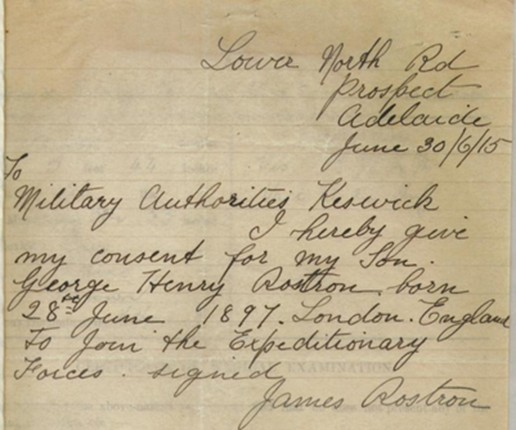
His younger brother Jack also enlisted when he was old enough in mid-1918 (No. 55884). He was sent to England and then assigned to the 43rd Battalion, but he came down with pneumonia and was returned to Australia, just a few months after he arrived. George was assigned to the newly formed 32nd Battalion, B Company. A and B Companies were made up of recruits from South Australia and C and D Companies came from Western Australia.
There was much fanfare about this new battalion in South Australia, with gatherings, community support, such as the Cheer-up Society, and reviews of the troops by the Premier. The men from WA who had been at the Blackboy Hill Camp near Perth arrived in Adelaide at the end of September and the whole battalion was assembled at the Cheltenham Racecourse Camp. Training continued until the battalion departed for Egypt on 18 November 1915, with the unit being split between two troop ships HMAT A2 Geelong and HMAT A13 Katuna. George was aboard the Geelong.
As reported in The Adelaide Register:
“The 32nd Battalion went away with the determination to uphold the newborn prestige of Australian troops, and they were accorded a farewell which reflected the assurance of South Australians that that resolve would be realized.”
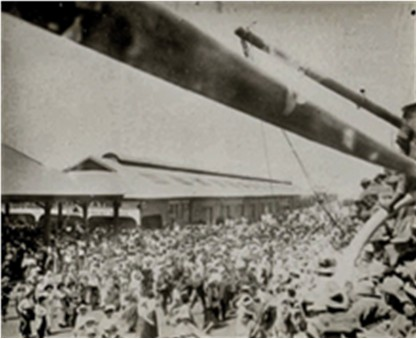
George arrived in Suez on 14 December 1915 and then moved to the camp at El Ferdan just before Christmas. A month later they marched to Ismailia and then to the major camp at Tel-el-Kebir where they stayed for February and most of March. Tel-el-Kebir was about 110 km northeast of Cairo and the 40,000 men in the camp were comprised of Gallipoli veterans and the thousands of reinforcements arriving regularly from Australia. Their next stop was at Duntroon Plateau and then at Ferry Post until the end of May where they trained and guarded the Suez Canal.
Their last posting in Egypt was a few weeks at Moascar. One soldier’s diary complained of being “sick up to the neck of heat and flies”, of the scarcity of water during their long marches through the sand and he described some of the food as “dog biscuits and bully beef”. He did go on to mention good times as well with swims, mail from home, visiting the local sights and the like.
Source - AWM C2081789 Diary of Theodor Milton PFLAUM 1915-16, page 29, page 12
During their time in Egypt the 32nd had the honour of being inspected by H.R.H. Prince of Wales.
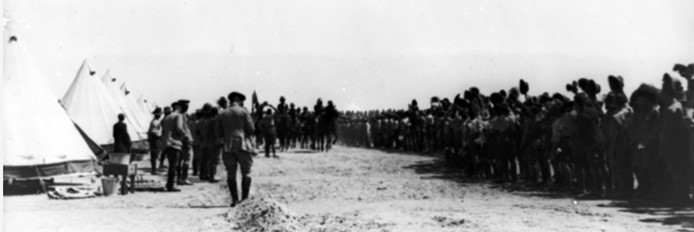
Fromelles
After spending six months in Egypt, the call to support the British Expeditionary Force on the Western Front came in mid-June. The 32nd left from Alexandria on the ship Transylvania on 17 June 1916, arriving at Marseilles, France on 23 June 1916 and they then immediately entrained for a three-day train trip to Steenbecque. Their route took them to a station just out of Paris, within sight of the Eiffel Tower, through Boulogne and Calais, with a view of the English Channel, before disembarking and marching to their camp at Morbecque, about 30 kilometres from Fleurbaix. Theodor Pflaum (No. 327) and Wesley Choat (No. 68) wrote about the trip:
“The people flocked out all along the line and cheered us as though we had the Kaiser as prisoner on board!!” – Theodore Pflaum
“The change of scenery in La Belle France was like healing ointment to our sunbaked faces and dust filled eyes. It seemed a veritable paradise, and it was hard to realise that in this land of seeming peace and picturesque beauty, one of the most fearful wars of all time was raging in the ruthless and devastating manner of "Hun" frightfulness”. – Wesley Choat
They were headed to the area of Fleurbaix in northern France which was known as the ‘Nursery Sector’ – a supposedly relatively quiet area where inexperienced Allied troops could learn the harsh realities of Western Front trench warfare against the Germans. But the quiet times did not last long.
Training continued with a focus on bayonets and the use of gas masks, assuredly with a greater emphasis, given their position near the front. The 32nd moved to the Front on 14 July and George was into the trenches for the first time on 16 July, only three weeks after arriving in France.
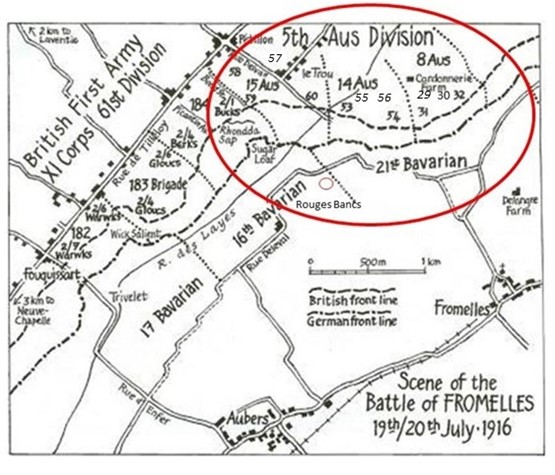
On the 17th they were reconnoitering the trenches and cutting passages through the barbed wire, preparing for an attack, but it was delayed due to the weather. D Company’s Lieutenant Sam Mills’ letters home were optimistic for the coming battle:
“We are not doing much work now, just enough to keep us fit—mostly route marching and helmet drill. We have our gas helmets and steel helmets, so we are prepared for anything. They are both very good, so a man is pretty safe.”
The overall plan was to use brigades from the Australian Fifth Division to conduct a diversionary assault on the German trenches at Fromelles. The 32nd Battalion’s position was on the extreme left flank, with only 100 metres of No Man’s Land to get the German trenches. As they advanced, they were to link up with the 31st Battalion on their right. However, their position made the job more difficult, as not only did they have to protect themselves while advancing, but they also had to block off the Germans on their left, to stop them from coming around behind them.
The Zero Hour for advancing from their front-line trenches was to be 5.45 PM, but the Germans knew this attack was coming and were well-prepared. They opened a massive artillery bombardment on the Australians at 5.15 PM, causing chaos and many casualties. The charge over the parapet began at 5.53 PM. George’s B Company was in the third and fourth waves. They were successful in the initial assaults and by 6.30 PM were in control of the German’s 1st line system (map Trench B), which was described as “practically a ditch with from 1 to 2 feet of mud and slush at the bottom”.
Source - AWM4 23/49/12, 32nd Battalion War Diaries, July 1916, page 11
Unfortunately, with the success of their attack, ‘friendly’ artillery fire caused a large number of casualties because the artillery observers were unable to confirm the position of the Australian gains. They were able to take out a German machine gun in their early advances, but were being “seriously enfiladed” from their left flank.
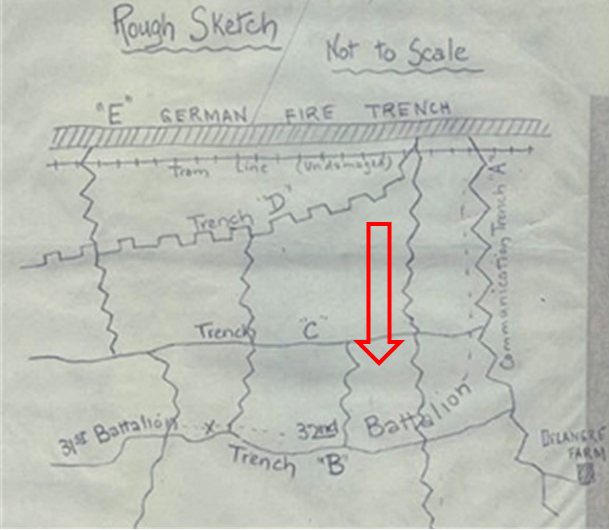
By 8.30 PM their left flank had come under heavy bombardment with high explosives and shrapnel. Return bombardment support was provided and the 32nd were told that “the trenches were to be held at all costs”.
Source - AWM4 23/49/12, 32nd Battalion War Diaries, July 1916, page 12
Fighting continued through the night. The Australians made a further charge at the main German line beyond Trench B, but they were low on grenades, there was machine gun fire from behind them from the emplacement at Delangre Farm and they were so far advanced that they were getting shelled by both sides. In the early morning of the 20th, the Germans began a counterattack from the Australian’s left flank, bombing and advancing into Trench A (map).
Given the Australian advances that had been made earlier, the rear Trench E had been left almost empty, which then enabled the Germans to regain that trench and envelop the men of the 32nd. At 5.30 AM the Germans attacked from both flanks in force and with bombing parties. Having only a few grenades left, the only resistance they could offer was with rifles:
“The enemy swarmed in and the retirement across No Mans’ Land resembled shambles, the enemy artillery and machine guns doing deadly damage.”
What was left of the 32nd had finally withdrawn by 7.30 AM on the 20th. The initial roll call count was devastating – 71 killed, 375 wounded and 219 missing. To get some perspective of the battle, when Charles Bean, Australia’s official war historian, attended the battlefield two and half years later, he observed a large quantity of bones, torn uniforms and Australian kit still on the battlefield.
The final impact was that 228 soldiers of the 32nd Battalion were killed or died from wounds sustained at the battle and, of this, 166 were unidentified. Lieutenant Sam Mills survived the battle. In his letters home, he recalls the bravery of the men:
“They came over the parapet like racehorses……… However, a man could ask nothing better, if he had to go, than to go in a charge like that, and they certainly did their job like heroes."
After the Battle
There are no witness records of what happened to George during the battle. Curiously, an 11 August 1916 entry in his AIF records show him as being killed on 17 July, which was communicated back home, but the formal declaration of his death dated 21 July 1916 states he was killed on the 19th.
George’s B Company was in the front line on the 17th doing parapet repairs and two soldiers were killed and seven wounded on that day, but there must have been some confusion from the roll calls. Had he been killed on the 17th his body surely would have been recovered.
As in the family notice, George was clearly missed by his family and friends.
George was awarded the 1914-15 Star Medal, the British War Medal, the Victory Medal and a Memorial Plaque and a Memorial Scroll. He is commemorated at:
- V.C. Corner Australian Cemetery Memorial Fromelles, France,
- Adelaide National War Memorial,
- Australian War Memorial Roll of Honour
- and the Prospect Roll of Honour WWI Board.
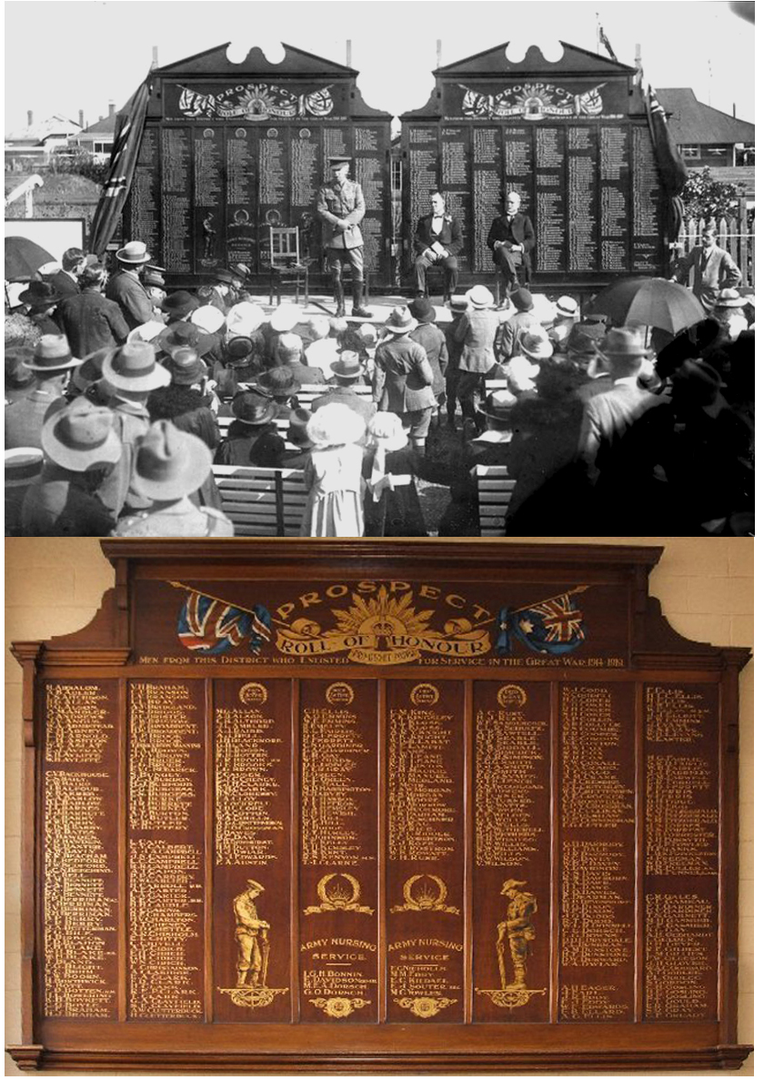
Could George Still be Found?
After the battle, the Germans collected 250 soldiers who were later buried at Pheasant Wood. The 32nd was fighting in the vicinity of the grave site and, as of 2024, 41 of the 166 unidentified soldiers from the 32nd have been able to be identified by DNA matching from family members.
A total of 180 soldiers have been identified. George could be one of the remaining 70 unidentified soldiers from the grave, but we are still searching for suitable family DNA donors. If you know anything of George’s contacts here in Australia or his relatives from England, and possibly the USA, please contact the Fromelles Association.
DNA samples are being sought for family connections to
| Soldier | George Henry ROSTRON (1898-1916) b Paddington London, died Fromelles |
| Parents | James Rostron (1859-1938) and Kate Louisa LAWS Name (1867-1935) married in New York, 1891. |
| Siblings | Alice (1882 - ) | ||
| James (Jim) (1892- 1991) m Doris Vera Jackson, son Donald | |||
| John Leonard (Jack) (1900-1939), m Eva Maud Newy, daughter Barbara Gladys | |||
| Albert Edward (Ted) (1901-1960) m Doris Irene Murphy, son Geoffrey Dean | |||
| Edith Sarah (1908-1965) m Harry Ralph, 2 children |
| Grandparents | |||
| Paternal | James Rostron and Susannah Yates, Lancashire | ||
| Maternal | William Laws and Ann Allgate, Ditchinham Norfolk |
Seeking DNA Donors

Contacts
(Contact: carla@fromelles.info or geoffrey@fromelles.info).
(Contact: army.uwc@defence.gov.au or phone 1800 019 090).
Donations
If you are able, please contribute to the upkeep of this resource.
(Contact: bill@fromelles.info ).
